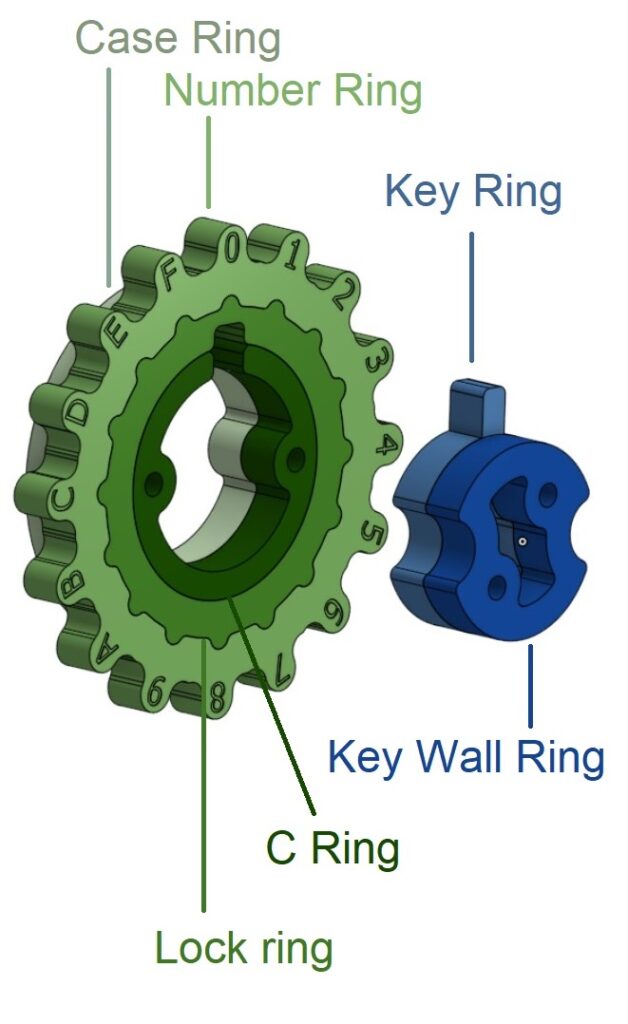Cryptex
What is a cryptex?
The cryptex is a cylindrical, portable storage with a mechanical number lock. It’s like a miniature safe. Small objects can be locked in it, which can only be removed if you know the combination of letters or numbers required to open it: the password. The device was made famous by the book The Da Vinci Code, which claims that the cryptex was the invention of Leonardo da Vinci. In fact, the structure existed centuries before him. Throughout history, the cryptex served the purpose of sending secret messages and small objects in it with a courier so that he could not know what he was delivering.


My cryptex
As I browsed around, I quickly found a dozen of cryptex designs that could be made with a 3D printer. Surely many were inspired by the book or the movie. 3D printed cryptexes are often described as useful escape room props for locking away keys or key items.
However, I could not find a cryptex that can be produced by laser cutting. There are at least two reasons for this:
- Fewer people have laser cutters than 3D printers.
- With laser, flat sheets can be cut from one side, but a cryptex is built up from cylindrical elements.
Since the laser cutter was at my disposal, I decided to deal with the rest of the difficulties and made a Cryptex out of lasercut wooden disks.
The names of the parts and their functions
When opened, the cryptex can be pulled apart into two parts. I call the outer part the Lock Half and the inner part the Key Half.


Both halves consist of rings with different purposes, which are held together by threaded rods and nuts. The advantage of the ring design is that it allows a modular structure – the cryptex is therefore built up of lock segments per password letter. And the number of segments can be chosen: You can put together a 1-letter or a 100-letter cryptex from them. The freedom of variability is only limited by the length of the threaded rods, because they must be cut to the length for the selected number of segments.
A segment is made up of the following parts:

| Name | Function |
Lock Half | Case Ring | In the closed state, the spikes of the key half are located here. Stationary structural element. |
Number Ring | The numbers are engraved on it. Rotates with the Lock Ring. | |
Lock Ring | It is connected to the Number ring in a similar way as a splined shaft, and it rotates together with it. Under the opening number, there is a cut-out the size of a key spike, through which the key spikes can move. | |
C Ring | The Lock ring rotates on it. Stationary structural element. |
Key Half | Key Ring | The ring with the key pin. |
Key Wall Ring | Ensures the longitudinal position of the key rings. |
Challenges and specific solutions of the structure
The Number Ring and Lock Ring must remain rotatable despite the tightening of the threaded rods. I ensured this by placing 2 washers between each ring segment, which keep the standing rings a little further apart. The rotating rings thus have a wider range of motion, so they are not squeezed between the stationary rings.

Since I can only engrave with a laser in the same direction as the cut, the inscriptions had been forced onto the flat surface of the rings. With this design and this size, 10 digits seemed too few, 26 letters too many, so I wrote the numbers of the 16 number system on the engraved number ring.
Any Cryptex password can be changed: To do this, the Lock Half must be disassembled (the nuts must be unscrewed at the opened state), then when reassembling, the Number Ring-Lock Ring pairs must be aligned so that the cut-outs of the Lock rings are under the corresponding characters.
The threaded rods and nuts holding the structure together are completely hidden by the glued end elements and only become visible when the cryptex is opened. As a result, the cryptex cannot be unscrewed without a password.
Material thickness plays an important role in usability. According to my experience, it is worth cutting out of at least 5 mm material in order to be able to rotate it comfortably.

Final words
Due to its size, the created cryptex prototype only allows the storage of very thin objects, but a larger version could have more possibilities.
In order to make the demonstration of my cryptex more exciting at events, I 3D printed a matryoshka doll maze cylinder downloaded from thingiverse, inside which I hid the code needed to open the cryptex. In the cryptex, I wanted to put some kind of reward for opening it, but due to the lack of space, only words of praise and memes could fit in it. The visitors still appreciated the experience.
